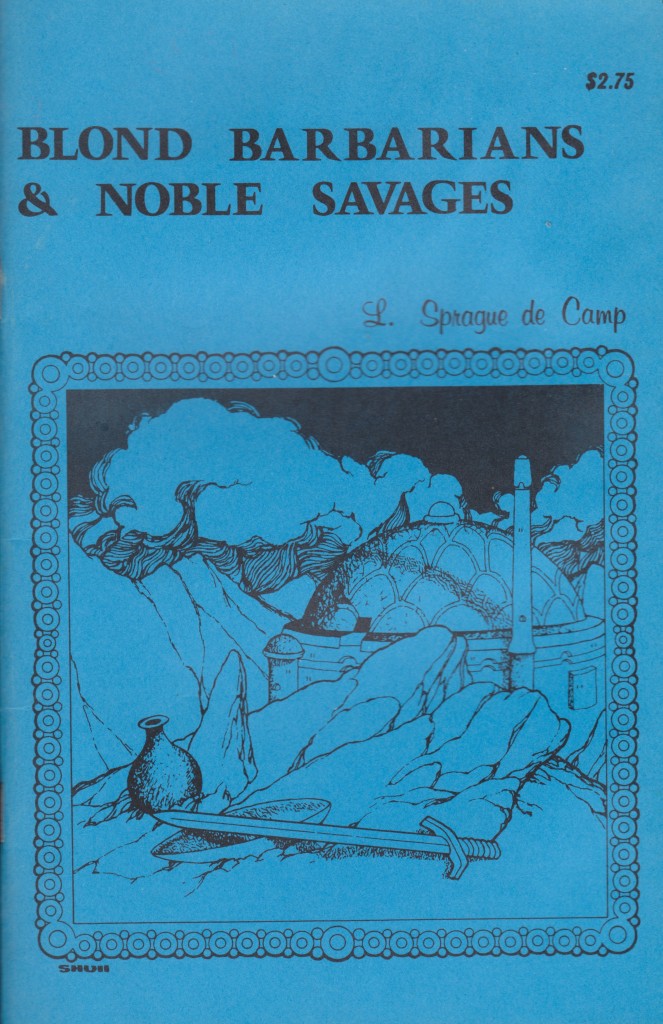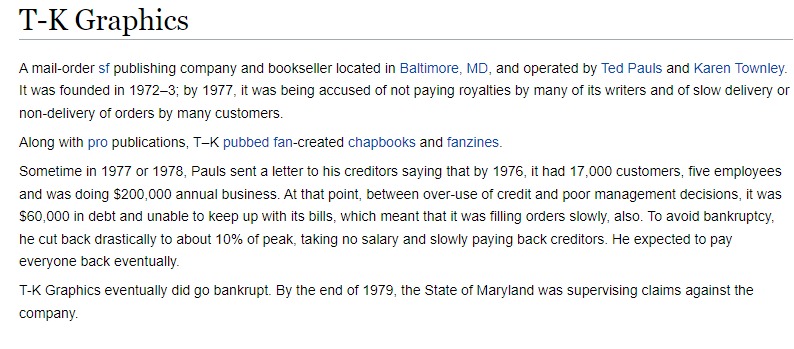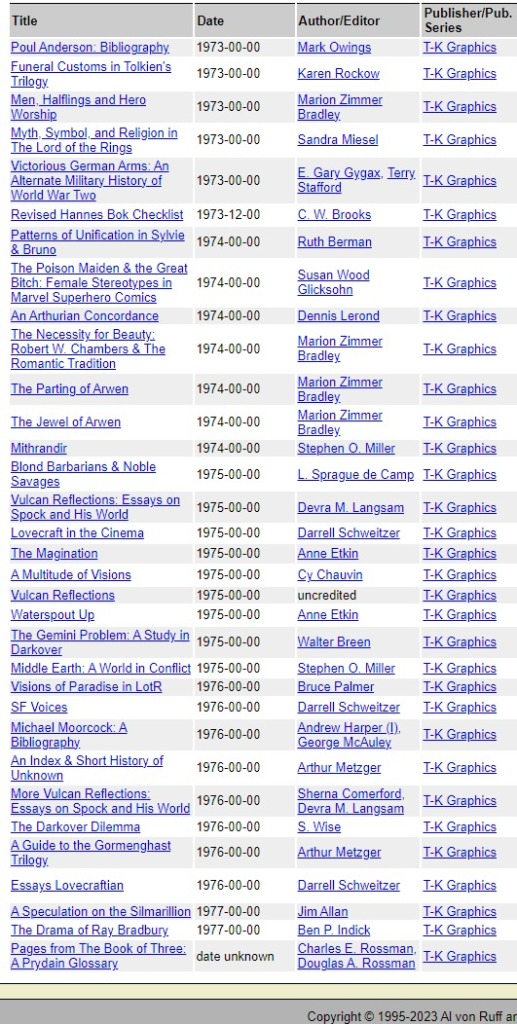by Phil Sawyer
I first bought this 46-page pamphlet in 1975. It has been a treasured “one of my first” Sprague works. I recall that the publisher “T-K Graphics” was a fantasy and SF book specialist. I was pleasantly surprised when they published a work of Sprague’s! For a 19-year-old with very few nickels to rub together it was quite a treat! Now at the hoary age of 67 I have reread it and still find it thoroughly enjoyable!

In the introduction Sprague tells us “This group of essays is a collection of ideas that have come to me in studying the lives and works of H. P. Lovecraft and Robert E. Howard, the history and mythology of peoples whom they wrote about, and the results of modern investigations of those peoples. If I ramble a bit, blame that on the fact that the things of which I write are widely scattered in time and space. They are linked by literary and ideational influences spanning continents and centuries.”
The first chapter is titled “Lovecraft and the Aryans.” From 1915 to 1922, Lovecraft issued an amateur periodical, “The Conservative.” There he defended patriotism, militarism, Prohibition, and the British Empire. In the first issue (April 1915) he published an editorial, “The Crime of the Century.” Sprague writes ” As this strange outburst shows, Lovecraft had been converted to the myth of the blue-eyed Nordic Aryan, later made notorious by Adolf Hitler. With memories of Dachau fresh, we tend to look upon one who speaks thus as a bloodthirsty maniac. But throughout human history, every ethnos-race, nation, tribe, or sect-has looked upon itself as superior.”
Sprague reminds us that “In the early years of the 20th century, ethnic prejudice was so rife that it seemed the natural order of things. People who call modern America “racist” don’t know what real racism is.”
Sprague points out that many of Lovecraft’s contemporaries were antisemitic: Henry Adams, Henry Fairfield Osborn (who “hated Jews with a Hitlerian passion”) and many others. Sprague writes that “Lovecraft’s Aryanism has greatly harmed his reputation and possibly prejudiced some later critics against him. Yet he only followed a common course. Most people embrace beliefs, not because of compelling evidence or ironclad logic, but because these beliefs comfort them and make them feel superior. Then they hunt around for evidence to back their beliefs. Lovecraft’s falling for [this] nonsense proves, not that he was an evil man, but that he accepted the nativist prejudices of his time, place, and class, and that he was much less objective, astute, and judicious than he would have liked people to think.”
An irony Sprague points out on page 13 is that when Lovecraft called Jewish culture “repulsive” he was ” only expressing his emotions towards what, in his ignorance, he imagined Jewish culture to be. He never, apparently, realized that some features of this culture, such as sobriety, sexual puritanism, bookishness, and a wry, self-mocking humor, were precisely his own qualities.”
Lovecraft learned better. On page 18 Sprague tells us of Alice Rachel Sheppard who taught German in the public schools of Providence. She visited Germany in 1936. “A good look at the Third Reich, where persecution of the Jews was getting into high gear, disillusioned her. She soon returned to Providence, where her eyewitness stories of Nazi cruelties appalled the tender-hearted Lovecraft.” By 1936 Lovecraft’s Judaeophobia had evaporated. Weeks before his death he attended a New Deal rally and was delighted with “the phenomenal penetration & wit of the main speaker, Rabbi Henri Wise.” Sprague concludes this chapter writing “No matter how wrong-headed now seem some of the stands he took, at least he kept on learning better all his life. And to what better use can one put one’s mind?”
The second chapter is titled “Howard and the Celts.” Robert E. Howard was more objective towards the Celts than Lovecraft was towards the Anglo-Saxons. However, “Howard harbored, throughout his life, a burning interest in Celtic history, anthropology, archaeology, and mythology.” Sprague tells of Howard’s fascination with the Picts and tells us of what (at that time) was known about them. The Dark Ages really were dark, and on page 24 Sprague reminds us that “The story of European migrations, conquests, and cultural borrowings is so complex and so filled with uncertainties that even the most conscientious popularizer despairs of presenting it in detail.” You still get an excellent de Camp look at what we do know and what we might know about those chaotic centuries.
On page 30 Sprague writes “For all his Irish sympathies, Robert Howard was not altogether naive about the Celts. He blamed his Celtic blood (perhaps unfairly) for endowing him with a restless, unstable mind, which gave him no rest. In his black moods, he cursed the “black Milesian blood,” which filled him with a “nameless sorrow in the black stars,” while “white weeping winds are tugging at my heart forever.” It filled him with “blind brooding rage” at anything that crossed his path.”
Sprague concludes this fascinating chapter by examining the “intransigent factiousness” of people besides the Celts including the Classical Greeks and the medieval Italians. “Such fragmented societies have often produced admirably creative people. But they are self-limited. Sooner or later, some powerful outsider gobbles all the little units, and the people have to learn wider loyalties under foreign masters.”
The third chapter is titled “The Heroic Barbarian.” He takes a look at the romanticizing of barbarians. One of the major influences was Rousseau. The “weepy Swiss philosopher” praised primitive life. Sprague points out that Rousseau did not know “any savages, noble or otherwise.” On page 36 Sprague writes that “Rousseau was not the utter fool that selected quotations from his writings can make him appear.”
Sprague writes of the “Romantic illusion” of the primitive golden age. Jack London, Rudyard Kipling, and Edgar Rice Burroughs greatly influenced REH. Howard’s idealization of primitive life was the natural result.
Sprague then writes of several real-life barbarians that he had known and tells us “There they are: a jolly, sensual woodsman; a devout, conscientious, patriarchal moralist; and a bright but grasping, hot-tempered, and rather obnoxious youth. All had good and bad points like other men, but none bore the slightest resemblance to Conan.”
Sprague points out that the real-life adventurers who are unconventional, uninhibited, versatile, and adaptable, who wander the earth, and who get mixed up on hair-raising escapades, affrays, and imbroglios are more likely to be civilized men. The men who lived Conanic lives were men like Marco Polo, Sir Francis Drake, and Sir Richard Francis Burton. Even King Harold Hardraade, a seven-footer whose real-life adventures sound more fictional than most fiction, was more or less civilized.
Sprague notes that the fictional barbarian heroes generally come to early and tragic ends. “Bellerophon is bucked off Pegasus in flight, Siegried is stabbed in the back, and Arthur is slain by his illegitimate son. Most of their prototypes perished likewise, usually at the hands of fellow adventurers. “The real-life King Clovis of the Franks was perhaps “too grimly efficient” to get into the epics!
Sprague guesses that the ageless attraction of the heroic barbarian is “his loss of inhibitions. He has left the toilsome, dreary humdrum round of normal barbarian life. He has escaped his usual milieu, with its tabus and etiquette, but he had not taken on the mores of the conquered, whom he despised because he had beaten them. Hence, he feels that he can get away with anything. He sees no reason not to obey every whim and lust. He acts like a bumptious adolescent, liberated from his parents’ control but not yet fitted into the mold of adult civilized life. ”
Sprague points out the fall of the Western Roman Empire shows “The squalid chaos that ensues can perhaps be enjoyed by one with a typical gangster mentality but not by many others.”
We are reminded that such “overgrown juvenile delinquents” are not good life insurance risks! However, multitudes will enjoy, if only vicariously, the uninhibited life of the conqueror, especially the barbarian conqueror of the Sigurdh type. Conan and his fictional colleagues will probably, therefore, continue popular for many years to come.”
I am guessing that this is a pretty rare de Camp item. If you ever see one, grab it! It’s Sprague at his best! Witty, learned, informative, and wise!
Yours in Crom.

Bonus: Some info about T-K Graphics (from various internet sources).




Author Darrell Schweitzer sent me a reply that I’m posting here:
TK Graphics was my first publisher. I do not have fond memories of the relationship. In addition to being a small press publisher, he was at one time THE major retailer of new books at conventions, rather like Sally Kobee today. But he was not a very good businessperson. Like many people at the time, I wondered how Ted Pauls stayed out of jail. The state of Maryland did investigate him, but there was no prosecution for mail fraud somehow. He was taking money through the mails and not filing the orders. My guess is that he got away with it because he ripped off a lot of people for small amounts rather than a few people for large amounts, which would have made it more actionable. Once he was clearly in financial trouble, he was selling books at 50% of list, which meant he had no intention of paying the publishers. Eventually no publisher would ship him a book. Before he faded from the scene entirely, he was last seen selling non-book items, like buttons and leather goods, at a few conventions.
I actually settled with him. I knew he would never pay any more royalties on LOVECRAFT IN THE CINEMA, ESSAYS LOVECRAFTIAN, and SF VOICES, so I took several crates of the books, and some of his stock. I actually sold off all the ESSAYS LOVECRAFTIANs, kept track of the proceeds, and paid royalties to the authors. (Fritz Leiber called me a “hero” for this.) In the course of this I learned that he had only reported the sales of 300 copies of LOVECRAFT IN THE CINEMA but in fact had sold the entire print run of 1000.
I almost got away free, but Pauls also had in his hands the manuscript and (much more importantly) the original artwork for a book of Lovecraftian humor I had edited, called ELDRITCH LAUGHTER FROM BEYOND. Alas, I made the mistake of telling someone I thought was a friend, another TK Graphics editor/author, what was going on, and this person passed the “rumor” back to Pauls. He then became angry, threatened to sue me, and refused to return the artwork for ELDRITCH LAUGHTER, although he lied about doing so. It was lost, presumably forever. The artist had put quite a lot of work into it and gotten nothing for his efforts. It was wonderful artwork, too, by an artist who later became established in the comic book industry.
I am told that one of the authors picketed the T.K. Graphics table at a worldcon for a couple days before collecting royalties.
The first thing I did upon joining SFWA at this time was go to their Grievance Committee about TK Graphics. They issued a warning, but there was nothing much else they could do.
This is not to say that Pauls did not mean well at the beginning. I am sure he did. But it is when fan entrepreneurs start to go broke that you find out who is honest and who is not.
I ordered from them back in the day and never got the product. Small amount. Maybe $10 or so. Your book Lovecraft in the Cinema and I think Cy Chauvin”s book. I sorta knew Cy from the Wayne Third Foundation. I lived in Detroit at the time and went to events at Wayne State University, so I saw/spoke to him a little bit at their SF meetings/cons. I had a letter in one of their zines. It was dopey. Think I was 15 or 16 at the time.
There is a good book from 1971 called The World of Late Antiquity which has spawned a lot of revisionist work on the so-called Dark Ages. I don’t want to belittle the reading of the author of Lest Darkness Fall and the Dragon of the Ishtar Gate but it’s worth pointing out because that book has inspired so much creativity.
BTW: “The Dark Ages” comment (in this particular article) comes from Phil Sawyer (who wrote the article) not from de Camp.
Pingback: de Camp’s other essays, more essays | Tentaclii